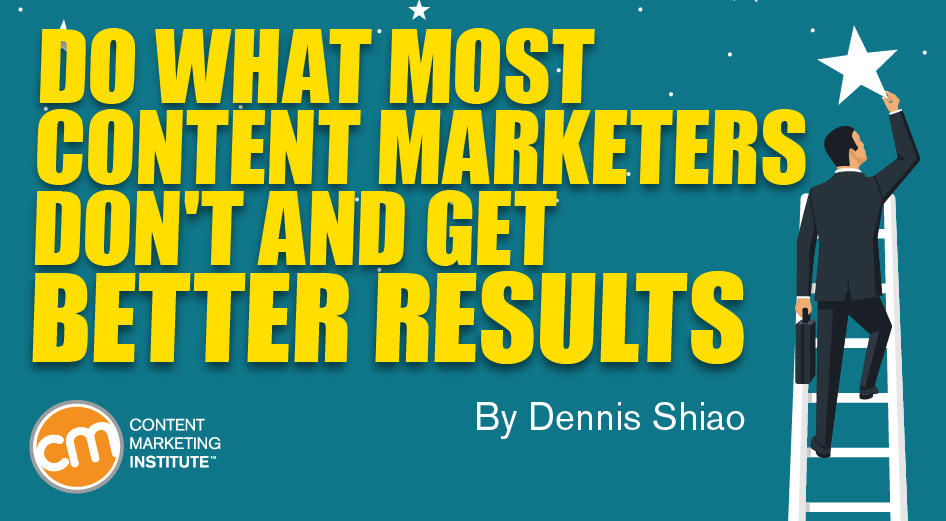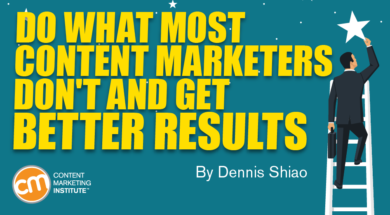 Let’s begin with some simple math:
Let’s begin with some simple math:
0.28 x 0.47 x 0.15 x 0.65 = 0.0128
The answer, expressed as a percentage, is 1.28%. I know what you might be thinking: What happened to the content I’m used to reading here at Content Marketing Institute?
Let me explain.
Take the four numbers on the left side of the equation and turn them into percentages:
- 28% of brands have a documented content mission statement, according to annual research from Content Marketing Institute and MarketingProfs.
- 47% of companies published original research in the past 12 months, according to a report from Mantis Research.
- 15% of B2B brands implement influencer marketing via “consistent, integrated campaigns,” according to research from Traackr and Altimeter Group.
- 65% of bloggers publish guest posts on third-party websites, according to Orbit Media’s annual blogger survey.
By implementing these four tactics (i.e., documented content mission statement, publishing original research, implementing influencer marketing, and writing guest posts for third-party sites), you can be in the top 1.28% of all organizations’ marketing teams.
That was the premise of Andy Crestodina’s Content Marketing World session, Content Strategy and SEO for B2B Lead Generation.
I’ll summarize Andy’s advice for each of the four tactics and connect the dots to tie them with B2B lead generation.
Documented content mission statement
A content marketing team without a documented content mission statement is like a nonprofit organization without a cause. For the 72% of brands without a documented content mission statement, I hope they find the time to create one this year.
A #content team w/ out a documented content mission statement is like a nonprofit org w/ out a cause. @crestodina Click To TweetIt’s important. It’s also simple. Andy gives this excellent template:
“Our content is where (audience x) gets (information y) that offers (benefit z).”
In a single sentence, you capture:
For Andy’s company, Orbit Media, the content mission statement is: Our content is where digital marketers find practical advice on content, analytics, and web design to get better results from their websites.
To summarize:
- Target audience = digital marketers
- Key topics = content, analytics, and web design
- Benefit to readers = better results from their websites
A content mission statement helps two constituents: your target audience and your internal teams.
For your target audience, the mission statement is outward-facing. As Andy says, “The mission statement becomes an amazing call to action. Wherever you ask your visitors to engage with you and subscribe, you can use that to tell them what they’re subscribing for.”
That’s why Orbit Media features its content mission statement as the headline of its blog. It’s right above its email sign-up form:
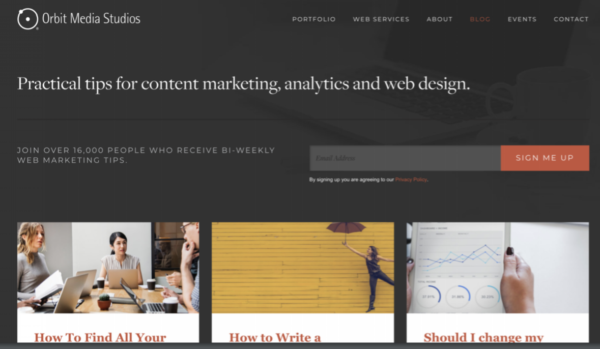
The content mission statement indicates to visitors whether the site serves their goal – are they in the right place?
For your internal teams (i.e., everyone who plays a role in planning, publishing, and promoting your content), the mission statement is inward-facing. It gets everyone on the same page.
You can use the mission statement in editorial and content planning meetings. When an idea is proposed for an infographic, the team can ask whether it aligns with the mission statement.
As the content team grows, the mission statement is a simple, yet effective onboarding vehicle. A content writer who joins an organization without a content mission statement immediately faces challenges and uncertainty.
A writer who joins an organization w/out a #content mission statement immediately faces challenges. @crestodina Click To TweetA new content writer at an organization with a content mission statement starts on solid footing.
HANDPICKED RELATED CONTENT:
Original research
Andy references research performed by BuzzSumo and Moz on over 1 million articles. As BuzzSumo’s Steve Rayson writes, “We wanted to look at the correlation of shares and links, to understand the content that gets both shares and links, and to identify the formats that get relatively more shares or links.”
The research includes this sobering finding: “In a randomly selected sample of 100,000 posts, over 50% had two or less Facebook interactions (shares, likes or comments) and over 75% had zero external links.”
Missed opportunity: Over 75% of 100,000 posts had zero external links. @BuzzSumo @Moz #research Click To TweetWhat type of content does well with shares and links? Original research.
As Steve writes, some specific content types have a strong positive correlation of shares and links – research-backed content and opinion-forming journalism. “We found these content formats achieve both higher shares and significantly more links,” he says.
#Research-backed content & opinion-forming journalism get higher shares & significantly more links. @crestodina Click To TweetAs proof of the effectiveness of original research, Andy shows this screenshot from Orbit Media’s Google Analytics:
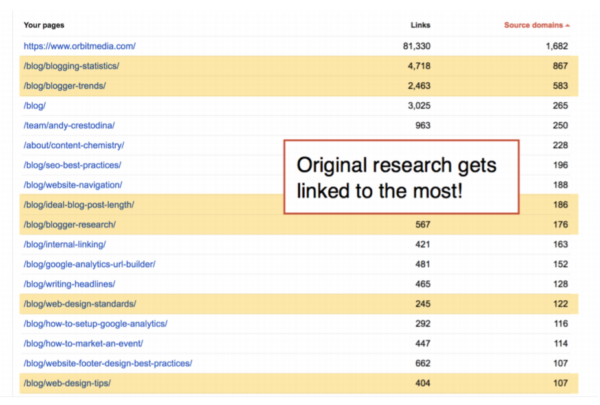
Articles featuring its original research received the most inbound links (i.e., other sites linking to those Orbit Media articles).
Andy details three approaches to original research – the amount of time and effort grows with each one:
- Observation
- Aggregation
- Big survey
HANDPICKED RELATED CONTENT:
Research via observation
Andy received this question from a client: “Should we have a search box on our website – is that standard?” As Andy wasn’t aware of any standards, he used the question as the impetus for observation-based research.
He downloaded a list of the top 50 marketing websites from alexa.com. Then, he listed 10 frequently used attributes or elements on websites and asked a virtual assistant to identify the inclusion of those potential “standards.”
Here’s the resulting article: Web Design Standards: 10 Best Practices on the Top 50 Websites. And the results for the article derived from observational research include:
- 126 links from other websites
- 118,000 readers
- 2 position in Google for a search on “web design standards,” ranking higher than the W3C (i.e., the World Wide Web Consortium).
Research via aggregation
Andy didn’t have first-party data to answer a question – how much money do marketers make – but he knew who did.
“Payscale.com and Glassdoor.com have a lot of data about this, right? Self-reported data on compensation for marketers. So I go to those two sites and I download their data,” Andy explains.
He presented the data by listing marketing job titles with their median salary. Eighteen months later, Andy analyzed a fresh set of data from the same sites. Now, he could show changes and trends for each job title.
He curated the data to tell a story that the original sources didn’t – or at least didn’t report. “It’s kind of like (creating) news,” Andy says.
The article was reprinted (with his permission) by the American Marketing Association in its print magazine:
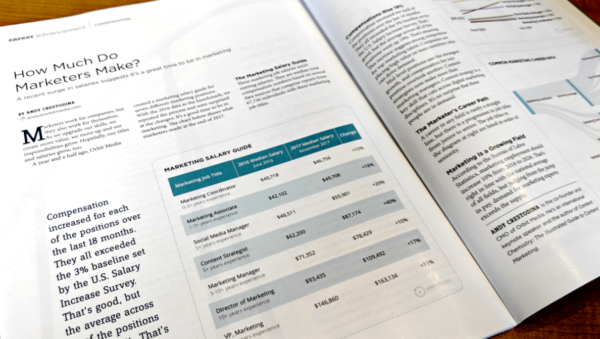
Research via big survey
An example of a big survey is Orbit Media’s annual blogger survey, which is in its fifth year. The survey began after Andy and team wondered, “How much does it take to write a blog post,” and couldn’t find an authoritative, data-backed answer on the web.
Each year, Andy and team send the survey to over 1,000 bloggers. They analyze the data for the current year and show how metrics have changed from one year to the next.
“Our goal is to find the thing that people often say, but rarely support,” Andy says. “In each industry, there are missing statistics. Find and produce the missing statistic and people will beat down your door to get to the data.”
Find & produce the missing stat in your industry & people will beat down your door to get to the data. @crestodina Click To TweetIn addition, people will link to your site. To date, over 16,000 sites have linked to the blogger survey. Why? Because any author mentioning the average time to write a blog post wants to cite the authoritative source, which now is Orbit Media’s research.
The blogger survey might be Orbit Media’s most time-consuming project of the year. For Andy, the effort is worth it. The time scales linearly; the results, however, grow exponentially. “I spend 120 hours every year on that survey. It’s a big job, but here’s my thesis. It’s maybe 10 times the amount of work of a typical project, but it generates 100 times the results,” he says.
Influencer marketing
According to Orbit Media’s blogger survey, 47.71% of marketers report “strong results” when using influencer outreach to promote their posts:
47.7% of marketers report “strong results” from influencers promoting blog posts. @orbiteers #research Click To Tweet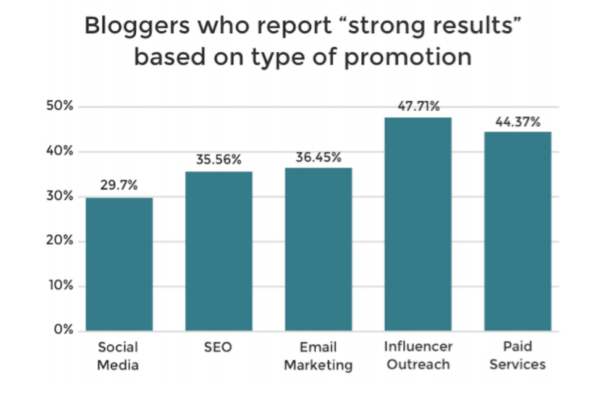
Given its effectiveness, what’s the best way to get influencers to share your content?
According to Andy, it’s to create content with the influencers. Their contributions add quality and depth to your content – and, influencers are naturally inclined to promote it. They’re in the content, after all!
Creating #content w/ influencers is the best way to get them to share it, says @crestodina. #influencermarketing Click To TweetFor the Orbit Media blogger survey, marketing influencers Ann Handley, Brian Clark, Gini Dietrich, and Joe Pulizzi all promoted it. (Andy included them in the content.)
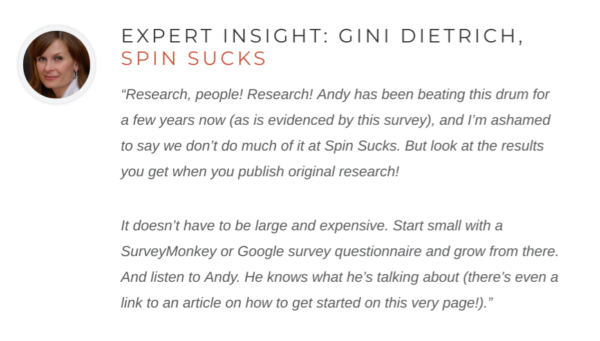
“When influencers create your content with you, you’ve just leveraged a very powerful cognitive bias called reciprocity bias. Anyone who creates content with you is very likely to help you promote that content. An ally in creation is an ally in promotion,” Andy says.
Andy recommends three ways to incorporate influencers into your content:
- Contributor quote
- Expert roundup
- Deep-dive interview
Like the example with Gini (above), the contributor quote serves to provide third-party validation to points made in the article. “I’m almost ready to make this just a rule, like an editorial standard. Don’t publish without a quote from a contributor, just like a journalist wouldn’t publish without a source,” Andy says.
I reached out to John Branch, sports reporter for The New York Times, for his expert advice on using quotes: “There’s no rule with quotes – except that I detest boring ones, the kind that don’t add emotion or surprise. They should not be used to convey information better stated (or already stated) by the writer. Quotes are like diamonds. They should sparkle. Use them sparingly.”
I detest boring quotes, the kind that don’t add emotion or surprise, says @JohnBranchNYT. Click To TweetIn an expert roundup, a set of influencers answers the same question. Their answers serve as the basis for your post.
In a deep-dive interview, you ask a series of questions to a single influencer. I’ve found success by sending experts open-ended questions via email. They often answer in paragraphs for each question. Not only are their answers useful and insightful, they’re often rich with keywords. They help my page rank far more effectively than if I optimized the page myself. After all, the content is contributed from an expert whose knowledge is deeper than my own.
HANDPICKED RELATED CONTENT:
Guest blogging
Time for an analogy.
You’re running for your town’s board of supervisors. You canvas the blocks in your neighborhood, asking people for their support. You blanket your street’s telephone poles with vote-for-me posters. You don’t, however, journey outside of your neighborhood.
What are your chances of winning? Not good. There’s a world outside of your neighborhood, but you’re only known within it. In the content world, it’s like publishing only on your website and forgoing third-party sites.
According to Orbit Media’s blogger survey, 34.5% of bloggers never publish guest blog posts. That’s a lost opportunity. As Andy explains, guest blogging exposes your brand and your content to new audiences. It gives you the opportunity to create inbound links to your website (e.g., links from your contributed post to relevant pages on your website).
34.5% of bloggers never publish on guest sites – that’s a lost opportunity, says @crestodina. #guestpost Click To TweetYou’ll also likely receive strong social promotion by the hosts of your guest posts because their goal is to drive traffic to their site.
Andy highlights the case of Aaron Orendorff, a marketer who aims to get his content published on mainstream sites such as Mashable, Inc., and Entrepreneur: “Aaron very carefully researches a publication, lovingly writes a piece that fits beautifully into their editorial standards, cites research, includes contributor quotes, provides internal linking, and includes headlines.”
Aaron’s pitch is quite simple: “I wrote this article for you. Here it is.”
Carefully research a pub & write a piece that fits within their editorial standards, says @AaronOrendorff #guestpost Click To TweetAaron’s pitch stands out from the many received by editors of major publications. “Aaron just gives them an amazingly beautifully crafted piece of content and they can just say yes to it. I love it,” Andy says.
HANDPICKED RELATED CONTENT:
Connecting the dots to lead generation
Congratulations!
You’re implementing the four tactics covered in this article. You’re now in the top 1% of all marketing organizations. The leads should start rolling in while you’re sleeping, right?
Not really.
While 10,000 people may visit your site to view your infographic, 9,999 don’t have an active need for the products or services you provide. They enjoy the infographic, but they don’t fill out any forms. They don’t convert.
According to Andy, “It’s really rare in my experience for visitors who come to a blog to actually become a lead on a typical B2B website.” He shows this real-world example from a site’s Google Analytics:
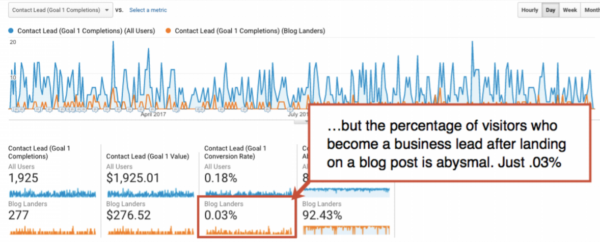
Of all the visitors to a blog post on this site, only 0.03% converted to a business lead.
Right now, you might be saying: “OK, you convinced me to become a top 1% B2B content marketer. For what? If my content doesn’t generate leads, do I fold up shop?”
Not at all.
The value of top-of-funnel content is to drive visibility, establish trust, and earn inbound links. Andy explains, “All those links to the content marketing content make your entire domain more credible, more likely to rank. They make every URL on your website more likely to rank, including the products and service pages, the pages for which the visitor who comes has commercial intent.”
Don’t expect your content marketing to lead directly to conversions. Instead, the mission of content marketing is to drive awareness, visibility, and authority, bolstering your chance of appearing when prospects search with commercial intent.
Don’t expect your #contentmarketing to lead directly to conversions, says @crestodina. Click To TweetTIP: Make sure your commercial-intent pages are optimized to drive the highest conversion possible.
HANDPICKED RELATED CONTENT:
Are you ready to be the top 1%?
Start with the easiest tactic then move to the next:
- Documented content mission statement
- Guest blogging
- Influencer marketing
- Original research
You should be able to come up with your site’s content mission in one to two weeks. Technically, a team member can define the mission in less than an hour, but more time is needed to gain consensus and buy-in across the team.
For guest blogging, allocate 25% of your content calendar to it. For every four posts you create, publish one on a third-party site.
For guest #blogging, allocate 25% of your content calendar to it, says @crestodina. Click To TweetInfluencer marketing and original research require dedicated resources. One option is to partner with agencies that specialize in these disciplines. They can provide consulting to help you get started or run the campaigns on your behalf.
It’s time to jump in.
Which of these tactics will you begin today?
Here’s an excerpt from Andy’s talk:
Gain insight like this from Andy Crestodina’s presentation in person in 2019. Make plans today to attend Content Marketing World Sept. 3-6.
Cover image by Joseph Kalinowski/Content Marketing Institute

